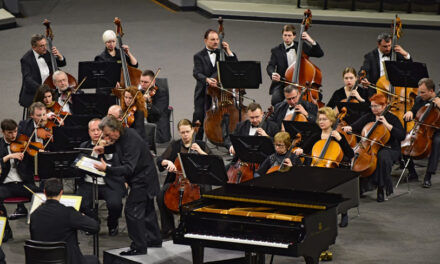Not long ago, the profession of playing the music of dead white male European composers was inhabited almost exclusively by white male musicians. Just when you think “you’ve come a long way baby” can apply to what should be a long-dead situation, you hear an incredible story like the first female member of the Berlin Philharmonic (a violist) being hired within the past five years! Fortunately, chamber music groups tend to be formed organically based on musical talent and comradeship and – at least in theory – democratically organized. In the past few years, the Triangle area has hosted several all-female piano trios, including the Ahn Trio, the Eroica Trio, and the Triple Helix Piano Trio, in residence at Wellesley College in Massachusetts.
The artists of Triple Helix were the headliners in the second annual mini-chamber music festival called “September Prelude,” which took place at the beginning of the official fall arts season. The festival featured two completely different concerts and master classes spread throughout different venues and hosted by several arts organizations. It is a unique and very successful collaborative venture that we all hope will continue for many years.
Regrettably, I was only able to attend the final event of Triple Helix’s residence – a concert at Duke’s Reynolds Theater on the perfect afternoon of Sunday, September 11. After the long summer musical drought, chamber music fans filed into this concert like tired, hot hikers approaching a water station. Violinist Bayla Keyes, cellist Rhonda Rider, and pianist Lois Shapiro are the separate but intertwining threads of the Triple Helix, and they proved to be as life-affirming and dynamic as their name implies.
The afternoon began with a sunny, optimistic work: Mozart’s E major piano trio, written in 1788. Although the program notes differentiate this late work from “earlier piano trios that belonged firmly in the tradition of keyboard sonatas with ad lib accompaniment,” this still primarily relegates the cello to a secondary role. To paraphrase an unrelated cliché, however, “there are no small parts, just small musicians.” Cellist Rider displayed a beautiful, focused, round tone that gave an integral foundation to the busier noodling above her. Pianist Shapiro was exemplary, playing the seemingly endless scales in a light and fleeting manner. The only problems came when there was a noticeable drop in tempo as she had to negotiate these fast passages across several page turns.
Mention “Shostakovich Trio” to chamber music fans and even the most knowledgeable will probably think of the second one, written in 1944. The last movement of that trio – it rips by at an illegal speed – has become a favorite encore for many piano trios. This more familiar trio was performed in Triple Helix’s Raleigh concert on September 9. The first trio, written in 1923, belies its status as a “student” composition. It is in one extended movement with many contrasting sections, and Shostakovich had already found his “voice” – it has his unmistakable stamp all over it. This work requires exceptional technique and razor sharp ensemble, and its emotions shift on a dime. Triple Helix was able to emerge from the innocence and transparent prettiness of the Mozart trio to project the spiritual, sardonic, and even grotesque elements that make Shostakovich such an emotionally wrenching ride.
One of the elements of these “September Prelude” festivals is the inclusion and collaboration of guest musicians. The second half of the program was taken up with one of the gems of the literature, the Piano Quintet in C minor by Gabriel Fauré. Joining the Helixers was violist George Taylor, Associate Professor of Viola at the Eastman School of Music and the violist of the Ciompi Quartet from 1979-86.
This quartet was written early in Fauré’s career yet shows a master’s sense of combining piano and strings. The writing – lush without being overly dense – presents a wide range of emotions, from lighthearted scherzos to almost obscenely passionate climaxes. Great performances like this are palpable and have their own physical presence – you could almost feel a collective tingle down your spine in certain sections. This work also has that unmistakable “French” sound although it would be difficult to put into words what that actually is. You could sense the commitment and energy that the four players poured into the work. The final movement built to such a tremendous emotional climax that violinist Keyes, previously staid and still, literally was propelled up and out of her seat. This was music at its best: a great work, great musicians who are emotionally involved, and the passion of the French!











